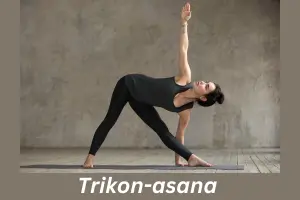Introduction
Trikonasana, commonly known as Triangle Pose, is a foundational asana in yoga that emphasizes balance, strength, and flexibility.
The name “Trikonasana” is derived from the Sanskrit words “trikona,” meaning triangle, and “asana,” meaning pose.
This posture forms a triangle shape with the body, promoting alignment and stability.

Trikonasana is often practiced in various yoga styles and sequences, making it a versatile addition to any yoga routine.
This pose not only enhances physical strength but also encourages mental clarity and focus.
As you stretch and open up the sides of your body, you cultivate a deeper awareness of your breath and body alignment, making it an excellent practice for yogis of all levels.
Steps to Perform Trikonasana (Triangle Pose)
- Start in Mountain Pose: Begin by standing tall in Tadasana (Mountain Pose) with your feet together and arms at your sides. Take a few deep breaths to center yourself.
- Step Your Feet Apart: Inhale and step your feet about 3 to 4 feet apart, ensuring your toes are pointing forward. Turn your right foot out 90 degrees, aligning your heel with the arch of your left foot. Keep your left foot slightly angled inward.
- Extend Your Arms: Raise your arms parallel to the ground, keeping them shoulder-width apart. Your palms should face down, and your shoulders should be relaxed.
- Bend from the Hips: As you exhale, hinge at your hips and reach your right hand toward your right foot. Keep your left arm extended upward, creating a straight line from your left fingertips to your left foot.
- Position Your Head: Gaze towards your left hand, maintaining a neutral neck position. If this feels uncomfortable, you can also look straight ahead or down at your right foot.
- Engage Your Core: Draw your belly button toward your spine to engage your core muscles, supporting your lower back throughout the pose.
- Hold the Pose: Breathe deeply and hold the position for 20 to 30 seconds, feeling the stretch along the sides of your body and in your legs.
- Come Out of the Pose: To exit, engage your core and push through your legs to rise back up to standing, bringing your arms down to your sides. Repeat on the other side by turning your left foot out and following the same steps.
Benefits of Trikonasana (Triangle Pose)
- Enhances Flexibility: Trikonasana stretches and lengthens the muscles in the legs, hips, and sides of the body, promoting overall flexibility.
- Strengthens the Legs: The pose engages the thighs, calves, and ankles, building strength and stability in the lower body.
- Improves Posture: Trikonasana encourages proper spinal alignment and helps correct postural imbalances, reducing the risk of back pain.
- Stimulates Digestion: The twisting motion of the torso in Triangle Pose can aid digestion and stimulate the abdominal organs.
- Relieves Stress and Anxiety: By encouraging deep breathing and body awareness, Trikonasana can help reduce stress and anxiety, promoting relaxation and mental clarity.
- Improves Balance and Coordination: Balancing in Trikonasana enhances coordination and stability, which can benefit other physical activities and daily movements.
- Opens the Hips: This pose is particularly effective in opening tight hips, which is essential for various yoga postures and functional movement.
Precautions and Contraindications for Trikonasana (Triangle Pose)
- Neck Issues: Individuals with neck injuries or discomfort should avoid looking up at the top hand. Instead, keep the gaze forward or down to protect the neck.
- Back Pain: Those with chronic back pain should practice this asana with caution and consult a healthcare professional if necessary to ensure proper alignment.
- Pregnancy: Pregnant individuals should avoid this pose or modify it under the guidance of a qualified instructor, especially in later trimesters.
- Hip Injuries: Those with hip issues should be cautious when performing the pose and may need to modify their stance or skip it altogether.
- High Blood Pressure: Individuals with high blood pressure should consult a healthcare provider before attempting this asana, as it may require modifications to avoid strain.
- Recent Surgery: If you have recently undergone surgery, especially in the abdomen or hips, consult a doctor before practicing this pose.
Conclusion
- This asana is a powerful and versatile yoga asana that offers a plethora of benefits for both the body and mind.
- By enhancing flexibility, strength, and balance, this foundational pose can significantly improve your overall yoga practice and physical fitness.
- Incorporating this asana into your routine not only promotes physical well-being but also fosters mental clarity and focus.
- As you explore this pose, remember to listen to your body, maintain proper alignment, and breathe deeply.
- With regular practice, you can experience the profound benefits of Triangle Pose, enriching your yoga journey and enhancing your quality of life.
- So, step onto your mat and embrace the transformative power of this asana.
- Enjoy the journey of self-discovery and growth as you deepen your practice and cultivate strength, balance, and tranquility.
